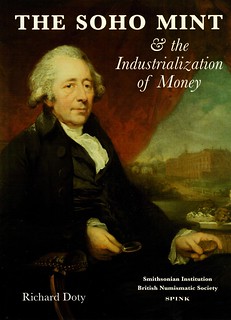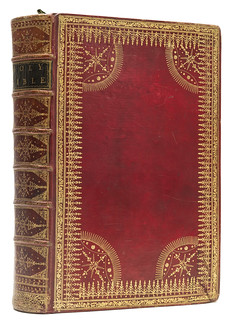
PREV ARTICLE
NEXT ARTICLE
FULL ISSUE
PREV FULL ISSUE
SALE REVIEW: BIRMINGHAM ASSAY OFFICE LIBRARYJohn Andrew submitted this great report on the recent sale of the Birmingham Assay Office Library. Thank you! -Editor 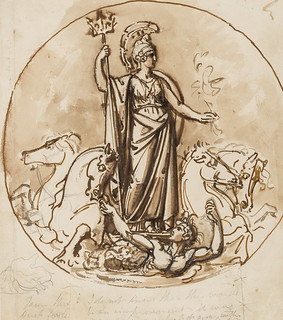

Corbould Britannia and St George Drawings JOHN ANDREW reports How on earth is this relevant to a numismatic publication? Matthew Boulton was born in Birmingham during 1728 and died there in 1809. By 1762 he was a major industrialist who had opened Birmingham's famous Soho Manufactory, which was purposefully designed to look like a palace. This pioneered mass production for a wide range of quality goods from buttons and buckles, steel jewellery and boxes and a few years later an extended Manufactory added luxury items such as silverware and ormolu. It was one of the first factories and certainly the most advanced one at its time in the world and lifted Birmingham to a centre of excellence, away from the 'brummagem', or inferior wares, produced there in the first half of the 18th century. 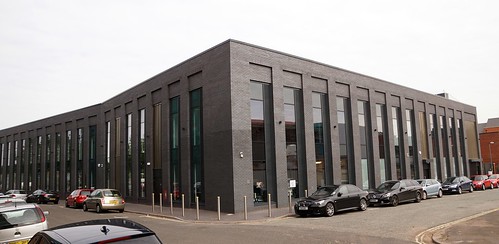
The Birmingham Assay Office Birmingham Assay Office The World's Pioneering Industrial Coiner In late 18th century Britain there was a shortage of circulating small change and counterfeiting became a profitable occupation. Boulton considered that the best way to stop this was to have a vast number of official coins in circulation that had a sufficient intrinsic value and were so well executed that making false ones would not be worthwhile. An improved version of Watt's rotative engine made this possible, but in official circles his ideas initially fell on deaf ears. The first Soho Mint was largely constructed from 1788-1789. By 1792 he had eight coin presses in operation at Soho with each capable of striking from 50 to 120 coins a minute. Boulton employed many of the best die engravers of the day, with the German Conrad Heinrich Küchler probably being the most prolific. As well as contract work for the Royal Mint and the striking of private tokens that circulated in the UK from 1787, he sent coins and tokens from Birmingham around the world – from India to Chile from Canada to Australia. In addition to installing steam-driven minting machinery at the Royal Mint, Soho also became an exporter of mints to Russia, Denmark and Brazil.
The Library The sale of the library has not been without its critics, including letters to the national press. Locally there was less of an outcry at the general sale of the books, but protest about just one in particular. A double-page spread in The Birmingham Post (The Post) for 5th March was headed, 'Boulton's own Bible Could be lost to the city'. Matthew Boulton is quite rightly held in the highest regard in the city. The Post describes him as the 'famed 18th century Birmingham industrialist'. At no point was it mentioned that the Bible probably left the City in 1815-16 when Matthew Boulton's son Matthew Robinson Boulton purchased the 8000 acre Great Tew Estate and manor in the Oxfordshire Cotswold Hills. Certainly he had added a Gothic Revival library in 1825. The Birmingham Assay Office bought the Bible and other volumes when Books from the library of Matthew Boulton and his family were sold by Christie's in December 1986. To address the criticism of the Bible leaving Birmingham, the Assay Office pledged £1000 towards keeping it on public view in the city. Doug Henry, the Assay Master told The Post, 'We are keen for the title to remain in Birmingham, kept in a suitable environment and for it to be more accessible. The Assay Office pledged £1000 to help acquire the book through the auction, to ensure its safekeeping in the city and its availability for public access. The Auction The Numismatic Books
Arguably the most important numismatic work in the sale, a manuscript, was the Minutes from the House of Lords' Committee of Council on Coin covering the period 1798-1802. During this time span, Soho 1797 Cartwheel two- pences and pennies were already in circulation, the Soho 1799 halfpennies and farthings were being placed into circulation and the Soho 1806 and 1807 pennies, halfpennies and farthings were not even ordered. In an age when such Minutes are printed, it is a shock seeing these handwritten. Inter alia, Matthew Boulton appeared before the Committee and was asked 1. What apparatus he would use to increase the Mint's output 2. How he would improve coins to render counterfeiting more difficult and the detection of counterfeits easier 3. Reduce operational costs. The Assay Office bought the Minutes when Books from the library of Matthew Boulton and his family were sold by Christie's in December 1986. This historically important document sold for £5000 against an estimate of £1000-£1500. 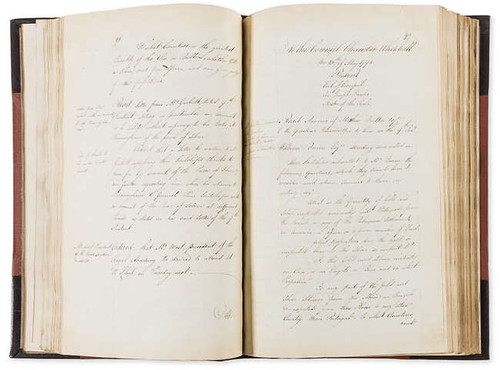
Minutes from the House of Lords' Committee of Council on Coin
Then I read on and my heart sank. There were the words, 'and 10 others, numismatic', with no mention of what they were. I rang Douglas Saville who, in 2007, after 37 years at Spink's Book Department, opened Douglas Saville Numismatic Books at Caversham just north of Reading. With 50 years in numismatic books, he is the doyen of the subject. He has certainly helped me form my numismatic library over the years. I asked him if he was going for the Cochran-Patrick lot, could I bag the Barnard. The answer to both questions was yes. Viewing the sale could well have been difficult for many potential bidders and the staff at Forum Auctions were very good providing information to potential bidders. Douglas did not view but requested images of the 10 books not listed. The lot sold for its top estimate of £750 including the Premium. This, how can I put it? 'Seems reasonable, not even knowing what the other 10 volumes were.' I noticed that Burns Coins of Scotland (three volumes, 1887) was not listed in the sales catalogue. Neither was it listed in the published 1914 Catalogue of the Books in the Library of the Assay Office Birmingham. Interestingly the following picked at random from the 1914 catalogue were not in the sales catalogue: Anselll, A Treatise on Coining 1862 or The Royal Mint 1871; Forrer, Biographical Dictionary of Medallists, coin engravers etc (six volumes 1902-1904); Hawkins, Medallic Illustrations of the History of Great Britain and Ireland to the Death of George II (two volumes 1885) but more importantly the series of superb plates issued by the British Museum from 1904-1911. Were all these included as 'and X more, numismatic'? Or were they retained or just been lost? Finale A few days after the auction The Birmingham Civic Society announced that Boulton's Baskerville family bible had been saved and will remain in Birmingham. The announcement stated, 'A consortium consisting of the Baskerville Society (consortium leader), Centre for Printing History & Culture (Birmingham City University and the University of Birmingham), the Cadbury Research Library, Birmingham Museums Trust, Birmingham Civic Society and the Lunar Society secured the bible. It will be housed in Birmingham at the Cadbury Research Library at the University of Birmingham, which has the appropriate resources to care for it, alongside the University's many other Baskerville holdings. In the 1970s the Assay Office passed its Matthew Boulton Archive to the Birmingham Central Library, now the Library of Birmingham. In retrospect some of the criticism of the Assay Office may not have been so harsh had it offered the House of Lords' Minutes to the Birmingham Central Library. It should have liaised with the Birmingham Civic Society regarding Boulton's Bible. Matthew Boulton is Birmingham's most famous son, indeed he is considered 'the Father' not only of the city, but the industrial West Midlands generally. So, do I condemn the Assay Office in selling the books from its library? NO I do not! A library is only useful if it is used. I have a great interest in modern British silver, as does Ken Quickenden, who until he retired, was Research Professor at Birmingham City University. For decades, he visited the Assay Office's Library when it was located at Newhall Street in central Birmingham. He was told that he was its most frequent visitor, albeit that he only looked at it the archives as opposed to its books. During his many visits he never encountered any other researcher! When the auction was planned, no one had a notion that the country would be placed in lockdown. This was very unfortunate, but Forum Auctions did everything to assist potential bidders. I feel justice was not done to the numismatic books and possibly the input from a consultant would have been useful. The coffers of the Assay Office have certainly been boosted. NOTES ON IMAGES The Birmingham Assay_Office
Bushell's Abridgement of the Lord Chancellor Bacon's Philosophical Theory in Mineral Prosecutions Corbould Britannia and St George Drawings Doty's The Soho Mint To read the earlier E-Sylum article, see: 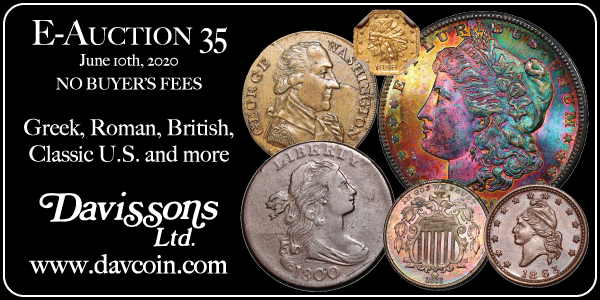 Wayne Homren, Editor The Numismatic Bibliomania Society is a non-profit organization promoting numismatic literature. See our web site at coinbooks.org. To submit items for publication in The E-Sylum, write to the Editor at this address: whomren@gmail.com To subscribe go to: https://my.binhost.com/lists/listinfo/esylum All Rights Reserved. NBS Home Page Contact the NBS webmaster 
|
